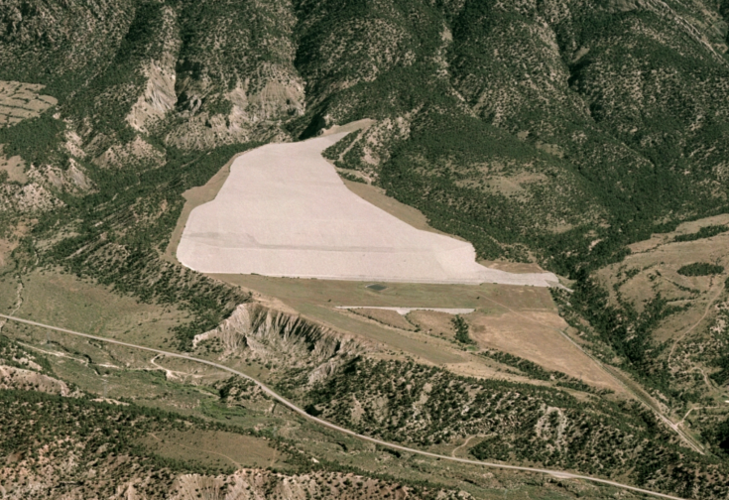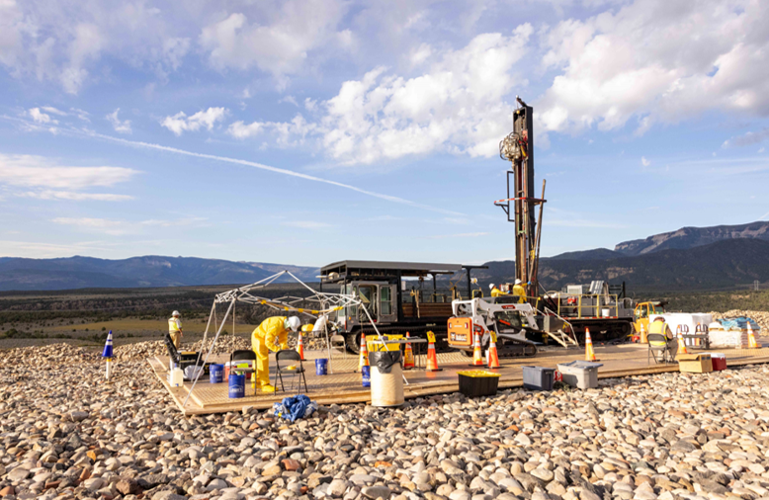A high-priority $7.2 million Department of Energy project to address water accumulation that threatened the structural integrity of a uranium milling tailings disposal site north of Rifle has been completed and is working as expected.
A team of DOE Office of Legacy Management experts devised the project to deal with the operational challenge that had developed at the 71-acre Rifle Disposal Site, which was built in 1996 — six miles north of Rifle in Estes Gulch. Known as a Uranium Mill Tailings Radiation Control Act (UMTRCA) Title I disposal cell, it contains about 3.5 million cubic yards of radioactive uranium mill components and mill tailings from two local former uranium and vanadium processing sites, known as Old Rifle and New Rifle, that were near the City of Rifle.
The repair project was managed by the Office of Legacy Management location in Grand Junction. Because of the significance of the problem the work was intended to address, it had been the highest-priority project for the entire Legacy Management portfolio, which includes more than 100 sites in the United States and Puerto Rico.
“The worst-case scenario would have been if the (site’s) side slope became oversaturated,” Mary Young, a Legacy Management site manager, said in response to emailed questions from the Sentinel. “The disposal cell integrity could have been affected and there could be a side slope failure, which could result in the release of contaminated materials into the environment.”
According to a DOE news release, in 2001, water started accumulating inside the cell and had to be pumped into a nearby lined evaporation pond. But as time went by, that system aged and was unable to keep up with the rapidly rising water levels, threatening the system’s structural stability, the release said.
The accumulating water consisted of what’s called pore water, which infiltrates the small spaces between grains of soil and sand. The cell had been designed to not interact with the local groundwater system. But Young said a steady increase of pore water in the cell began occurring in 2014.
“The source of the pore water is still being investigated, but one of the potential sources is precipitation infiltration through the (cell) cover. The cover system has a frost barrier that is between 6 to 19 feet thick across the cell, which could have become a water storage layer,” Young said.
According to a fact sheet on the site, the cell’s design promotes rapid runoff of precipitation to minimize infiltration. An interceptor ditch abuts the upslope portion of the cell to divert surface flow away from it, and a riprap apron and ditch at the toe of the cell carry water away from it.
DOE tried between 2019-24 to optimize its existing system to extract water from wells on the site. It redeveloped the wells and freeze-proofed infrastructure to try to maximize run time and be able to pump year-round, but that wasn’t enough, UMTRCA Team Lead Paul Kerl said in the release.

Photo special to the Sentinel
Crews work to install a well at a Department of Energy uranium mill tailings disposal site north of Rifle as part of a $7.2 million project to address water accumulation that threatened the structural integrity of the site.
“Seeing the water levels rising further, we assessed the risks associated with saturating the side slope of the disposal cell and realized a full court press was needed to implement a priority project to mitigate the risks in very short order. Only a multi-disciplinary, rapid-response, cross-functional team could develop and implement a project to quickly address these risks. Fortunately, the Office of Legacy Management has such a team,” said Kerl.
Team members in areas such as leadership, finance, regulatory, planning, design and construction, environmental compliance, project management, radiation safety, and contracting worked on the project, according to the release.
The team reviewed the cell’s construction and water accumulation to determine how many new extraction wells should be installed and where they should be placed for maximum efficiency and to try to avoid hitting buried mill materials during drilling. For project design purposes, a numerical groundwater flow model was developed to make up for the limited information about the cell that came from three standpipes, two of them with 30 years of water level records and a third that is dry.
Work began at the site last June. It involved bringing in a drilling rig and building a temporary road surface using interlocking construction mats to avoid disturbing the cell’s rock, riprap cover, according to the news release. “Super sacks” were used to store drill cuttings, including tailings material, away from the construction area, in a radiation control area marked with radiological hazard signs. Crews used a LIDAR, or light detection and ranging, system to scan the disposal cell and make sure its integrity was maintained during drilling. The system sends out a beam of light that reaches a point or points on the ground and bounces back to the instrument, and it confirmed that there was no movement in the cell as the work occurred.
Altogether, 10 additional extraction wells were drilled, so that 12 wells now actively draw water from the cell. Another four monitoring wells were drilled for measuring water levels in the cell. Also, two one-acre modular evaporative ponds were built to handle the additional extracted water, supplementing the one small pond that already was on the site. Solar power systems were installed, along with a system that lets Legacy Management operate and monitor the new extraction system remotely.
Once the construction was finished, land restoration was conducted, involving planting native plant seeds to revegetate the area and stabilize the disturbed soil.
Altogether more than 130 people worked on the project.
On Dec. 10 a first operational test demonstrated a steady flow of pore water from the cell into the evaporative tanks. Once the first few wells successfully pumped water the remaining wells were brought online, DOE says.
Young said that before the new wells were installed, about 20,000 gallons of water a month were being extracted from the site. Now, about 150,000 gallons a month are being extracted.
Site monitoring using data collected and transmitted remotely, along with adherence to a long-term surveillance plan, will continue to protect human health and the environment, DOE said in the release.
Young said in the release, “This project required personnel with expertise in many areas. We completed this complex project with a comprehensive approach that has allowed us to maintain the integrity of the disposal cell.”













